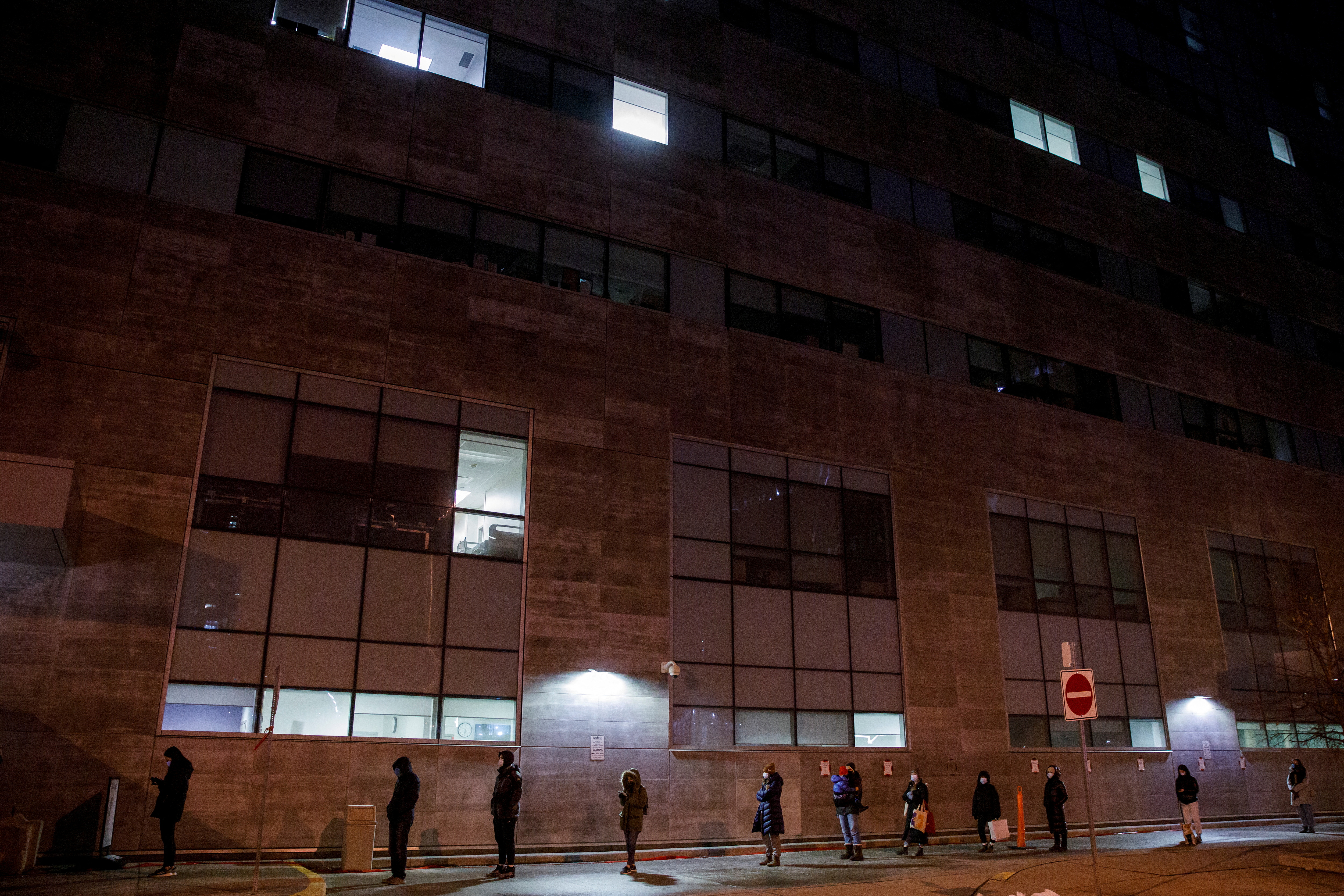Omicron Variant in Canada
"We hover between three and four patients in the ICU with Omicron. Those who are recovered but still in the ICU are from the Delta wave."David Jacobs, chair, Ontario Specialists Association, radiologist, Humber River Hospital, Toronto"Due to the transmissibility of Omicron, the absolute number of hospitalizations and impact on the health-care system is likely to be significant, despite possible reduced severity."Public Health Ontario"There is a rise in hospitalization [including ICU] due to the Omicron surge, but this is nowhere near what we would have seen with similar numbers of Delta."Isaac Bogoch, infectious disease specialist, University of Toronto
 |
| People queue up for their COVID-19 PCR test at Women's College Hospital, as the latest Omicron variant emerges as a threat, in Toronto, Ontario, Canada December 22, 2021. REUTERS/Cole Burston |
A growing slate of epidemiological data indicating Omicron as a variant which is more infectious than its predecessors, but yet far less likely to severely injure much less kill the people it infects, is being reflected in the Canadian experience. Scottish data published prior to Christmas found numbers similar to those in Ontario, relating to shrinking hospitalization rates: "Omicron is associated with a two-third reduction in the risk of COVID-19 hospitalization when compared to Delta", read their report.
This week a study out of South Africa -- known as the initial country to identify Omicron and alert the world community -- discovered only 4.9 percent of COVID-19 cases were ending up in hospital in comparison to a 13.7 percent hospitalization rate experienced during the previous Delta wave.
Initial reports of the Omicron variant painted a picture of uncertainty, of dark fear that the mutated virus's insatiable appetite for infecting greater numbers of people, would result in unprecedented death and destruction. That early results with numbers indicating a milder virus in circulation has seen a great sigh of relief exhaled, tempered with a wait-and-see attitude.
Over the holidays, British Columbia had 100 people admitted to hospital during a period of up to 50,000 new cases being verified. Similar results are being seen in Ontario where a new Public Health Ontario study found Omicron to be 54 percent less likely to result in death or hospitalization than previous COVID variants. "Omicron appears to be the first dominant variant to demonstrate a decline in disease severity", the report read.
Earlier waves saw hospitals so badly hit they were left with little option but to send away up to 100 patients weekly for treatment at outside facilities. Dr.Jacobs, a radiologist at Toronto's Humber River Hospital, reported the Omicron wave was largely defined by COVID-19 patients appearing at the emergency room with coughs and sore throats, minus severe pulmonary complications seen in previous waves.
As an example, he described performing X-rays of just four suspected COVID-related pneumonias, compared to up to 60 during the most recent wave of Delta patients. Severe cases, found Dr. Jacobs, seemed reserved fairly exclusively within the unvaccinated population; an impression supported by province-level data. The rate of unvaccinated Ontarians admitted to intensive care reflecting COVID onset was over 20 times higher than for people with at least two doses of vaccine.
While those impressions are hugely reassuring the ghost at the back of the health community's mind is Omicron's capacity to overwhelm the health-care system where even an exceptionally mild virus, should too many people become infected at once, can send ICUs into crisis. However, thus far the Canadian experience appears to exhibit what epidemiologists refer to as a 'de-coupling'; where in previous waves a rise in confirmed cases seemed a harbinger of deaths and hospitalizations to come, this time cases have been 'decoupling' from those serious indicators, whereby the infections spike hugely without yielding surges of severe illness.
Of 76,992 active cases, 726 were in hospital in Ontario mid-week, last. The last record high for active cases in the province was 42,917 in April, with 2,335 in hospital; half the cases, three times the hospitalization. Quebec, which is experiencing its third-highest number of COVID-19 hospitalizations since the beginning of the pandemic appears as the Canadian epicentre of the Omicron wave; in a rate of new cases at least four times higher than has yet been seen.
It took 2,000 new cases per day in Quebec a year earlier to plunge the province into full-fledged hospitalization crisis with 1,500 beds occupied by COVID-19 patients at its height. Quebec at the present time has just 939 hospital beds occupied by COVID patients despite a daily rate of new cases far higher than 2,000 for the past two weeks where cases stood at a soaring 14,000 per day.
 |
| People wait in line at a COVID-19 testing and vaccination site in Montreal, Wednesday, December 29, 2021, as the COVID-19 pandemic continues in Canada. THE CANADIAN PRESS/Graham Hughes |
"[The rodent studies show that Omicron] could be non-severe in the right context. [However the results should be taken with a grain a salt, given that these studies don’t focus on humans.]""[There's] some encouraging data at both the epidemiological and now in the rodent models that suggest Omicron could have the potential to cause disease less severe than Delta, for example. But it's not the same thing as saying that it's benign."Dr. Donald Vinh, infectious disease specialist, McGill University, Montreal
Labels: British Columbia, Canada, Global Pandemic, Hospitalization, ICU Beds, Infection Rate, Omicron Variant, Ontario, Quebec, Studies

0 Comments:
Post a Comment
<< Home